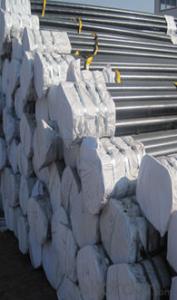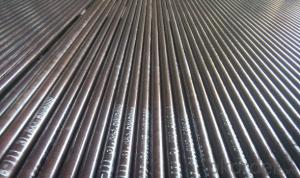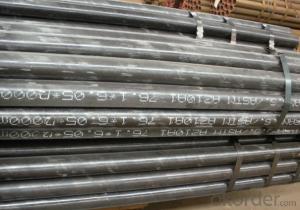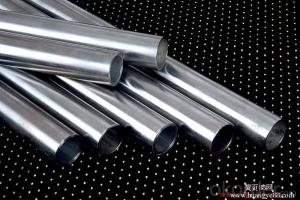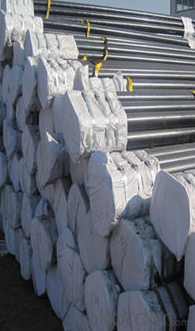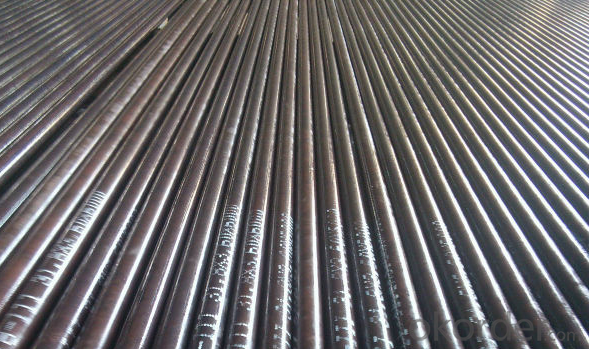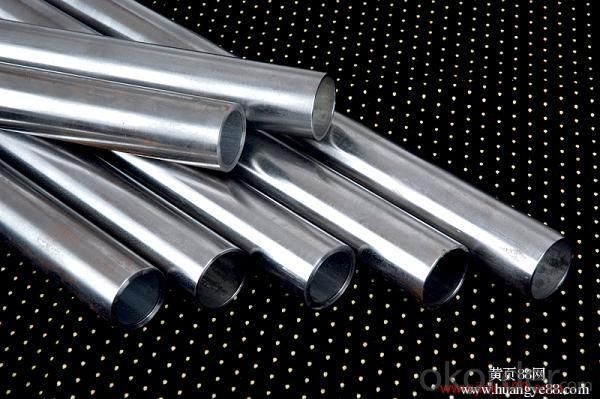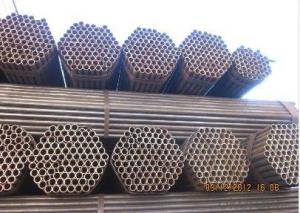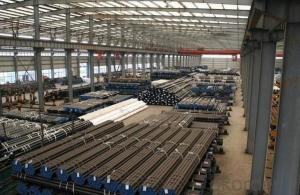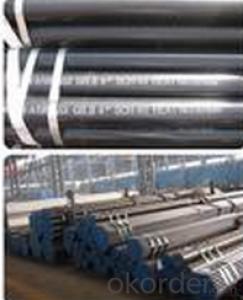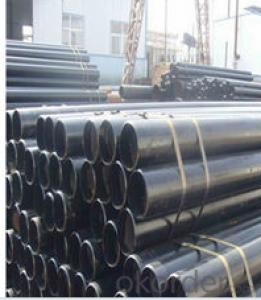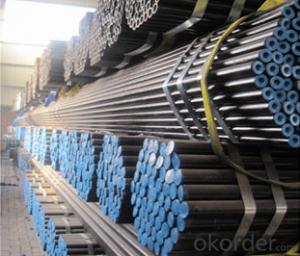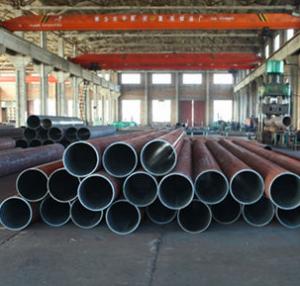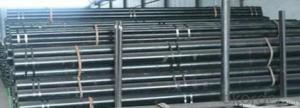Carbon Steel Seamless Pipe For Boiler API CNBM
- Loading Port:
- Qingdao
- Payment Terms:
- TT OR LC
- Min Order Qty:
- 10 pc
- Supply Capability:
- 30 pc/month
OKorder Service Pledge
OKorder Financial Service
You Might Also Like
Quick Details
| Thickness: | 1.2 - 20 mm | Section Shape: | Round | Outer Diameter: | 12.7 - 168 mm |
| Place of Origin: | Jiangsu China (Mainland) | Secondary Or Not: | Non-secondary | Application: | Boiler Pipe |
| Technique: | Cold Drawn | Certification: | PED | Surface Treatment: | oil coating |
| Special Pipe: | Thick Wall Pipe | Alloy Or Not: | Is Alloy | ASTM A213: | T2,T5,T9,T11,T12,T22,T23,T91,T91 |
| ASTM A335: | P1,P2,P5,P9,P11,P12,P22,P23,P91,P92 | DIN17175: | 15Mo3,10CrMo910,12CrMo195,13CrMo44 | Grade: | 12Cr1MoV,Cr5Mo,Cr9Mo,12Cr1MoVG,Cr5MoG,A335 P11,A335 P5,A335 P9,A335 P1,A213,A192,A210,A335 P12,A335 P23,St35.8,Cr-Mo alloy,A53-A369,ST35-ST52 |
| Standard: | BS 3059-2,DIN EN 10216-1-2004,DIN 17175,ASTM A213-2001,ANSI A210-1996,ASTM A179-1990,BS,DIN,ASTM |
Packaging & Delivery
| Packaging Detail: | Seaworthy export packing |
| Delivery Detail: | 45 Days |
Specifications
Standard: ASTM A179,ASTM A192,ASTM A210,DIN17175,EN10216-1
Material:P235GH,ST35.8,ST45.8
Manufacture method:cold drawn
Product Description
Commodity: Carbon steel seamless pipe for boiler
Standard&material: ASTM A179,ASTM A192,ASTM A210 Gr.A1,Gr.C,DIN17175 ST35.8,ST45.8,EN10216-1 P235GH,P265GH,etc.
Size range: 12mm*1.2mm - 168mm*20mm
Manufacture method: cold rolled, cold drawn
Delivery condition: Normalized, Normalized and Tempered.
Mill test certificate as per EN10204 3.1B is available.
Third party inspection is acceptable.
Tubes will be ECT+UT.
- Q: What are the factors that affect the pressure rating of steel pipes?
- There are several factors that can affect the pressure rating of steel pipes. These include the material and grade of the steel used, the wall thickness of the pipe, the diameter of the pipe, the temperature at which the pipe will be operating, and the type of fluid or gas being transported through the pipe. Additionally, factors such as corrosion, external loads, and installation methods can also impact the pressure rating of steel pipes.
- Q: What is the pressure rating of steel pipes?
- The pressure rating of steel pipes varies depending on its size, wall thickness, and the type of steel used. It can range from a few hundred pounds per square inch (psi) for smaller pipes to several thousand psi for larger ones.
- Q: What are the different methods of pipe bending for steel pipes?
- There are several methods of pipe bending for steel pipes, each with its own advantages and limitations. 1. Manual Pipe Bending: This method involves using hand tools or a manual pipe bender to bend the steel pipe. It is suitable for small-scale projects or when only a few bends are required. However, it requires skill and precision to ensure accurate and consistent bends. 2. Rotary Draw Bending: This method utilizes a mandrel, clamp die, and a bending die to bend the pipe around a stationary bend die. The mandrel helps to maintain the shape and prevent wrinkling or collapsing of the pipe during the bending process. Rotary draw bending is commonly used for producing tight-radius bends with high accuracy and repeatability. 3. Induction Pipe Bending: In this method, an induction coil is used to heat a specific area of the steel pipe, making it more malleable for bending. Once the desired temperature is reached, the pipe is bent using hydraulic or mechanical force. Induction bending is suitable for large-diameter pipes or when multiple bends are required in a single pipe. 4. Roll Bending: Also known as pyramid rolling, this method involves passing the steel pipe through three adjustable rolls that gradually bend the pipe into the desired shape. Roll bending is suitable for producing large-radius bends and is commonly used in the construction of spiral staircases, handrails, and structural applications. 5. Hot Bending: This method involves heating the steel pipe to high temperatures, typically using a furnace, to facilitate bending. Hot bending allows for greater flexibility in shaping the pipe and is commonly used for large-diameter or thick-walled pipes. However, it requires specialized equipment and expertise to control the temperature and prevent distortion or damage to the pipe. It is important to consider factors such as the required bend radius, pipe diameter, wall thickness, and project specifications when selecting the appropriate method of pipe bending for steel pipes. Consulting with an experienced pipe bending professional or engineer can help determine the most suitable method for a specific application.
- Q: Can steel pipes be used for scaffolding?
- Yes, steel pipes can be used for scaffolding. Steel pipes are commonly used in scaffolding systems due to their strength, durability, and ability to support heavy loads. They provide a stable and secure platform for workers to perform construction and maintenance tasks at various heights.
- Q: How are steel pipes used in the agriculture sector?
- Steel pipes are commonly used in the agriculture sector for various purposes, such as irrigation systems, drainage systems, and structural support for farm buildings and infrastructure. They are also used for conveying water, chemicals, and other fluids, as well as for constructing fencing and livestock enclosures. Moreover, steel pipes are utilized in the construction of machinery and equipment essential for farming operations.
- Q: Can steel pipes be used for underground pressure pipelines?
- Yes, steel pipes can be used for underground pressure pipelines. Steel pipes are known for their strength, durability, and resistance to corrosion, making them suitable for underground applications where pressure is present. Additionally, steel pipes can withstand high temperatures and external forces, making them an ideal choice for underground pressure pipelines.
- Q: 25 of the steel pipe with 6 in charge of what is the difference?
- Outer diameter representation of steel pipe:When the design is nominal diameter DN means diameter, should be nominal diameter DN and the corresponding product specifications table. Specification for unplasticized polyvinyl chloride pipes for building drainage, de (nominal outer diameter) * e (nominal wall thickness), (GB, 5836.1-92), polypropylene (PP) pipe for water supply, specifications by de * e (nominal outer diameter * wall thickness).
- Q: How do you calculate the pressure drop in a steel pipe?
- When determining the pressure decrease in a steel pipe, various factors need to be taken into account. These factors include the pipe's diameter and length, the fluid's flow rate, and the fluid's properties. One commonly utilized equation for calculating the pressure drop in a pipe is the Darcy-Weisbach equation. This equation is as follows: ΔP = (f * (L / D) * (ρ * V^2)) / (2 * D) In this equation: - ΔP represents the pressure drop in the pipe - f denotes the Darcy friction factor, which relies on the pipe's roughness and Reynolds number - L refers to the pipe's length - D represents the pipe's diameter - ρ signifies the fluid's density - V indicates the fluid's velocity To compute the Darcy friction factor, different methods can be employed depending on the flow regime. For laminar flow, the formula f = 16 / Re can be utilized, where Re represents the Reynolds number. For turbulent flow, the friction factor can be determined using various methods, such as the Colebrook equation or the Moody chart. It should be noted that the fluid's properties, such as viscosity and density, may vary with temperature and pressure. Thus, considering these variations is crucial when calculating the pressure drop. Moreover, it is important to acknowledge that additional factors, including fittings, valves, and elbows, can impact the pressure drop in a steel pipe. These factors introduce extra losses, which can be accounted for by employing appropriate correction factors or directly measuring the pressure drop across these components. Overall, calculating the pressure drop in a steel pipe necessitates the use of suitable equations, taking into account the fluid's properties, and considering the various factors that can influence the flow. It is advisable to consult relevant engineering handbooks or employ specialized software for accurate calculations.
- Q: Can steel pipes be used for culvert applications?
- Yes, steel pipes can be used for culvert applications. Steel pipes are commonly used for culverts due to their durability, strength, and resistance to corrosion. They can withstand heavy loads and are able to handle high traffic volumes and large water flows. Additionally, steel pipes can be easily manufactured in various sizes and shapes to suit specific culvert requirements. Their longevity and low maintenance needs make them a cost-effective choice for culvert applications.
- Q: How are steel pipes used in the manufacturing of ships?
- Steel pipes are used in the manufacturing of ships for various purposes, including structural support, fluid transportation, and ventilation systems. They are commonly used to create the framework of the ship, providing strength and stability. Additionally, steel pipes are used to transport fluids such as water, oil, and gas throughout the vessel. They are also utilized in the ship's ventilation system to ensure proper air circulation and maintain a safe environment for crew members.
Send your message to us
Carbon Steel Seamless Pipe For Boiler API CNBM
- Loading Port:
- Qingdao
- Payment Terms:
- TT OR LC
- Min Order Qty:
- 10 pc
- Supply Capability:
- 30 pc/month
OKorder Service Pledge
OKorder Financial Service
Similar products
Hot products
Hot Searches
Related keywords
